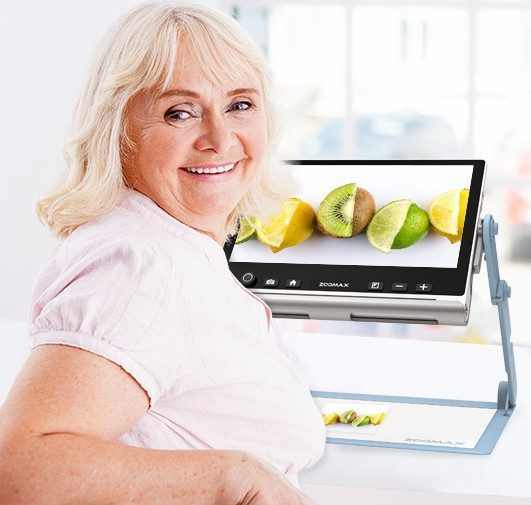 Introduction
Introduction
Access to assistive technology, such as electronic magnifiers and screen readers, is essential for individuals with visual impairments. However, the cost of these devices can be a significant barrier. Fortunately, many countries offer subsidies and financial assistance to ensure these essential tools are accessible. This article builds on our previous guide on Global Policies and Subsidies for Electronic Assistive Devices: A Comprehensive Guide Across the U.S., Canada, and the U.K. and focuses on the financial assistance programs in Australia, Germany, France, Spain, and Italy, providing specific examples in each country.
Australia
1. National Disability Insurance Scheme (NDIS)
Australia’s National Disability Insurance Scheme (NDIS) is a comprehensive program that provides funding for a wide range of supports, including assistive technology. The NDIS is tailored to the needs of individuals with disabilities and can cover devices like electronic magnifiers.
- Estimated Cost for the Individual: Varies; many devices are fully funded.
- Application Process:
- Eligibility Check: Individuals must first check their eligibility for NDIS.
- Planning Meeting: A planning meeting is conducted to determine the individual’s needs and goals.
- Approval and Funding: Once approved, the NDIS funds are allocated to cover the cost of the device.
 Example: A student with low vision in Sydney could receive a $1,500 electronic magnifier fully funded through the NDIS after their needs assessment.
Example: A student with low vision in Sydney could receive a $1,500 electronic magnifier fully funded through the NDIS after their needs assessment.
- More Information: Visit the NDIS website.
2. Employment Assistance Fund (EAF)
The Employment Assistance Fund (EAF) helps employees with disabilities acquire the necessary technology for work. This program ensures that individuals are fully supported in their professional environment.
- More Information: Visit the EAF page.
3. State-based Equipment Schemes
Programs such as EnableNSW in New South Wales and South Australia’s Equipment Program (SAEP) provide additional support for assistive technology, especially in areas where NDIS may not cover certain devices.
Germany
1. Health Insurance and Sozialgesetzbuch (SGB IX)
In Germany, statutory health insurance, Gesetzliche Krankenversicherung (GKV), covers assistive devices deemed necessary for daily life, education, or employment. According to Sozialgesetzbuch IX (SGB IX), people with disabilities are entitled to these devices at no additional cost if prescribed by a doctor.
- Estimated Cost for the Individual: $0 (if covered by insurance)
- Application Process:
- Obtain a Prescription: A doctor must prescribe the necessary assistive device.
- Submit to Insurance: The prescription is submitted to the health insurance provider.
- Approval and Delivery: Upon approval, the device is provided through a contracted supplier.
 Example: A 50-year-old professional in Berlin with a visual impairment could get a screen reader fully covered by GKV, allowing them to continue working effectively.
Example: A 50-year-old professional in Berlin with a visual impairment could get a screen reader fully covered by GKV, allowing them to continue working effectively.
2. Integrationsamt
Germany’s Integrationsamt provides additional support for workplace accommodations, including assistive devices. This helps employers cover the costs of adapting workplaces for employees with disabilities.
- More Information: Visit the GKV website and the Integrationsamt website.
France
1. Prestation de Compensation du Handicap (PCH)
France’s Prestation de Compensation du Handicap (PCH) offers financial support for assistive devices, and the amount covered depends on the individual’s needs and income. The Maison Départementale des Personnes Handicapées (MDPH) oversees assessments and fund disbursement.
- Estimated Cost for the Individual: Varies based on income and needs.
- Application Process:
- Needs Assessment: Conducted by the MDPH.
- Submit Application: The assessment is submitted to MDPH.
- Approval and Payment: Approved funds are provided to cover the cost of the device.
Example: A retired individual in Lyon could receive financial assistance through PCH to purchase a $2,000 portable electronic magnifier, significantly reducing the out-of-pocket cost.
- More Information: Visit the PCH website.
2. Allocation aux Adultes Handicapés (AAH)
AAH provides a minimum income to disabled adults with low income, complementing PCH. This can further reduce the financial burden of acquiring assistive technology.
- More Information: Visit the AAH website.
3. Aide à la Mobilité et au Logement (AML)
AML provides support for home adaptations and mobility needs, ensuring that the disabled can live independently.
- More Information: Visit the AML page.
Spain
1. Sistema para la Autonomía y Atención a la Dependencia (SAAD)
Spain’s Sistema para la Autonomía y Atención a la Dependencia (SAAD) provides financial assistance for assistive devices, supporting individuals with disabilities in achieving independence.
- Estimated Cost for the Individual: Varies based on needs and financial situation.
- Application Process:
- Needs Assessment: Conducted by local social services.
- Submit Application: The application is submitted with the assessment.
- Approval and Disbursement: Approved funds are allocated for the device.
 Example: A student in Madrid might receive funding through SAAD to acquire a $1,200 screen reader, making it affordable for their family.
Example: A student in Madrid might receive funding through SAAD to acquire a $1,200 screen reader, making it affordable for their family.
- More Information: Visit the SAAD website.
2. Bonos Sociales
Spain also offers Bonos Sociales, which provide additional financial aid for low-income individuals to help cover energy costs and other expenses, indirectly supporting their ability to afford assistive devices.
- More Information: Visit the Bonos Sociales page.
3. Pensión no contributiva por invalidez
This non-contributory pension provides financial support to individuals who are unable to work due to disability, further aiding in the purchase of necessary devices.
- More Information: Visit the Pensión no contributiva por invalidez page.
Italy
1. National Health Service (Servizio Sanitario Nazionale – SSN)
Italy’s Servizio Sanitario Nazionale (SSN) offers financial assistance for assistive devices through its regional healthcare systems. Depending on the individual’s needs and medical condition, devices may be provided free of charge or at a reduced cost.
- Estimated Cost for the Individual: Varies; can be fully covered or involve a small fee.
- Application Process:
- Medical Prescription: Obtain a prescription from a healthcare provider.
- Submit to SSN: The prescription and application are submitted to the SSN.
- Approval and Distribution: Once approved, the device is provided through the SSN.
 Example: A 60-year-old individual in Rome with a visual impairment might receive a $1,500 electronic magnifier with minimal out-of-pocket cost through the SSN.
Example: A 60-year-old individual in Rome with a visual impairment might receive a $1,500 electronic magnifier with minimal out-of-pocket cost through the SSN.
- More Information: Visit the SSN website.
2. Invalidità Civile
Invalidità Civile provides financial benefits and subsidies to individuals with disabilities, ensuring they have access to necessary devices.
- More Information: Visit the Invalidità Civile page.
3. Carta Acquisti
This social welfare card provides subsidies for food and medicine to low-income individuals, including those with disabilities.
- More Information: Visit the Carta Acquisti page.
As you explore the various assistive device programs available in your country, consider the Snow 12 electronic magnifier, a top-rated device for individuals with low vision impairments. Next, let’s take a look at its review video to further understand its features and benefits.
Conclusion
These countries provide various forms of financial assistance for electronic assistive devices. Whether through national health insurance, disability compensation programs, or specific subsidies, each nation offers support to ensure that individuals with disabilities can access the technology they need.
Frequently Asked Questions (FAQ)
1. How do I know if I qualify for financial assistance in my country? Eligibility criteria vary by country and program. Typically, you will need a medical diagnosis of a disability and a prescription for the assistive device. Check the specific program’s website for detailed eligibility requirements.
2. What is the application process like for these programs? The application process generally involves obtaining a medical prescription, submitting it to the relevant government or insurance body, and awaiting approval. It’s advisable to gather all necessary documentation and consult with healthcare professionals to streamline the process.
3. What can I do if my application for an assistive device is denied? If your application is denied, you can usually appeal the decision. This may involve providing additional documentation or undergoing a reassessment. You may also seek help from disability advocacy organizations that can offer guidance on the appeals process.
References
Australian Government. (2023). National Disability Insurance Scheme (NDIS). Retrieved from https://www.ndis.gov.au
Australian Government. (2023). Employment Assistance Fund (EAF). Retrieved from https://www.jobaccess.gov.au/employment-assistance-fund-eaf
New South Wales Government. (2023). EnableNSW. Retrieved from https://www.enable.health.nsw.gov.au
South Australia Health. (2023). South Australian Equipment Program (SAEP). Retrieved from https://www.sahealth.sa.gov.au/wps/wcm/connect/public+content/sa+health+internet/services/department+for+health+and+wellbeing+services/statewide+services/assistive+technology+services/south+australian+equipment+program+saep
GKV-Spitzenverband. (2023). Statutory Health Insurance in Germany. Retrieved from https://www.gkv-spitzenverband.de
Bundesministerium für Arbeit und Soziales. (2023). Sozialgesetzbuch IX (SGB IX). Retrieved from https://www.bmas.de/DE/Themen/Teilhabe-Inklusion/Rehabilitation-und-Teilhabe/sozialgesetzbuch-IX.html
Integrationsämter. (2023). Services for people with disabilities in the workplace. Retrieved from https://www.integrationsaemter.de
Service Public France. (2023). Prestation de Compensation du Handicap (PCH). Retrieved from https://www.service-public.fr/particuliers/vosdroits/F14202
Service Public France. (2023). Allocation aux adultes handicapés (AAH). Retrieved from https://www.service-public.fr/particuliers/vosdroits/F12242
Service Public France. (2023). Aide à la Mobilité et au Logement (AML). Retrieved from https://www.service-public.fr/particuliers/vosdroits/F34009
IMSERSO. (2023). Sistema para la Autonomía y Atención a la Dependencia (SAAD). Retrieved from https://www.imserso.es
Gobierno de España. (2023). Bonos Sociales. Retrieved from https://www.bonossocial.gob.es
Ministerio de Inclusión, Seguridad Social y Migraciones. (2023). Pensión no contributiva por invalidez. Retrieved from https://www.mscbs.gob.es/ssi/portada/home.htm
Ministero della Salute. (2023). Servizio Sanitario Nazionale (SSN). Retrieved from https://www.salute.gov.it
Istituto Nazionale Previdenza Sociale (INPS). (2023). Invalidità Civile. Retrieved from https://www.inps.it
Ministero dell’Economia e delle Finanze. (2023). Carta Acquisti. Retrieved from https://www.mef.gov.it/carta_acquisti.html

